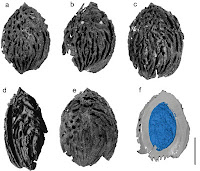The Earth's climate is known to fluctuate over time, requiring animals and plants to move in order to find suitable habitats. For animals this is a fairly easy task, since most animals constantly move in search of the optimum environments during their lives, however for plants this is much more problematic, as they live the majority of their lives rooted to a single spot, with dispersal only occuring during the seed stage. One way to track optimum conditions in a changing climate without traveling vast distances is to move up and down slopes, since on average a 100 m rise in altitude coresponds to a -0.65 °C drop in temperature. However, while a seed can easily move downslope throgh gravity or water dispersal, seeds cannot fall upslope, requiring the plant to find more creative ways to move seeds uphill.
In a paper published in the journal Current Biology on 25 April 2016 a team of scientists led by Shoji Naoe of the Forestry and Forest Products Research Institute examine the dispersal of the seeds of the Hill Cherry, Prunus verecunda, in Central Japan via two animal vectors, the Asiatic Black Bear, Ursus thibetanus and the Japanese Marten, Martes melampus.
Oxygen isotope ratios in plant tissue can be closely related to altetude, enabling Naoe et al. to estimate the altitude at which the trees that produced Cherry stones found in Bear and Marten droppings had been growing. Surprisingly they found that both species preferentially moved the seeds upwards, with Bears moving them an average of 749.5 m upslope and Martens 460.5 m, close to the maximum distance a foraging member of each species would be expected to travel between eating the fruit and excreting their stones.
The Hill Cherry produces fruit in spring-to-summer, with trees lower on the slope producing flowers, fruit and leaves earlier in the season. Bears, which were responsible for moving 80.3% of the Cherry seeds, have previously been shown to move upslope over the season enabling them to access fruit throughout the season. Naoe et al. suggest that the preferential movement of Bears and Martend uphill between consuming Cherries and defacating may reflect a daily feeding cycle, with the animals feeding first on the fruit, then moving upslope to forrage on herbs and young vegetation that cannot be accessed beneath the canopy of fruiting trees.
Vertical seed dispersal toward the mountain tops by mammals that are following the springto summer plant phenology. The spring-to-summer plant phenology proceeds from the foot to the top of mountains. Cherry fruits and young vegetation are no longer available in low altitudes, ripe fruits are available but young vegetation is no longer available in middle altitudes, and ripe fruits are unavailable but young vegetation is available in high altitudes. Naoe et al. (2016).
See also...
 Prunus kunmingensis: Peaches from the Late Pliocene of Yunnan Province. Peaches, Prunus persica, are widely grown and consumed fruit
around the world today, with a total annual production of about 20
million tons. They have a long historical association with humans,
particularly in East Asia, with the oldest known...
Prunus kunmingensis: Peaches from the Late Pliocene of Yunnan Province. Peaches, Prunus persica, are widely grown and consumed fruit
around the world today, with a total annual production of about 20
million tons. They have a long historical association with humans,
particularly in East Asia, with the oldest known... Changes in the diet of Brown Bears on Hokkaido. Expanding Human populations have
been the major factor affecting almost all of the Earth’s ecosystems since the
end of the last glaciation. Human activity has altered food...
Changes in the diet of Brown Bears on Hokkaido. Expanding Human populations have
been the major factor affecting almost all of the Earth’s ecosystems since the
end of the last glaciation. Human activity has altered food... Worker killed by Bear at Alberta oil sands site.
A
worker was killed in an attack by a Bear at an oil sands excavation
site operated by Suncor Oil, about 25 km north of Fort McMurray in
Alberta Province, Canada, around mid-afternoon on Wednesday 7...
Worker killed by Bear at Alberta oil sands site.
A
worker was killed in an attack by a Bear at an oil sands excavation
site operated by Suncor Oil, about 25 km north of Fort McMurray in
Alberta Province, Canada, around mid-afternoon on Wednesday 7...
